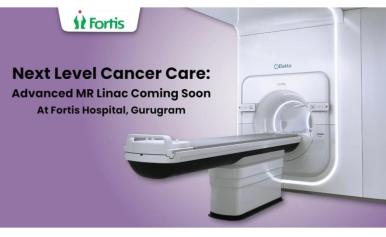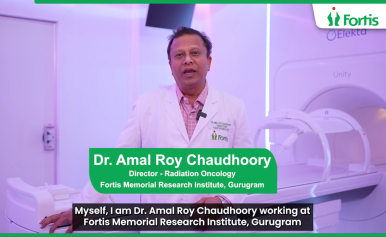MR Linac
Introduction to MR Linac at Fortis Hospital, Gurugram
Welcome to a new era of cancer treatment at Fortis Hospital, Gurugram, where cutting-edge technology meets compassionate care. We wish to introduce the MR Linac, an innovation poised to redefine precision in radiation therapy. This groundbreaking system seamlessly integrates a 1.5T MR, ensuring an uncompromised design for unparalleled accuracy in visualising the tumor and organs at risk. Explore with us the transformative capabilities of MR Linac and its potential to revolutionize personalized cancer treatment through MRI guided radiation therapy (MRgRT).

Uncompromised System Design with 1.5T MR
At the heart of the MR Linac system lies a powerful 1.5T magnetic resonance imaging (MRI) unit. This exceptional design choice ensures unparalleled image quality, enabling our clinicians to visualize tumors and surrounding tissues with extraordinary clarity. The integration of a high-field MR allows for real-time visualization of tumor during radiation delivery, ensuring that treatment adjustments can be made instantly, based on the most up-to-date information.

Advantages of 1.5T MR Integration:
1: High-Resolution Imaging: The 1.5T MR offers superior image resolution, providing detailed insights into the tumor and surrounding anatomy, facilitating precise treatment delivery. This level of clarity is especially crucial when dealing with tumors located near sensitive organs or structures.
2: Real-Time Adaptation: With real-time imaging capabilities, our clinicians can monitor and adapt the treatment plan as needed, ensuring accuracy throughout the entire radiation therapy session.
3: Reduced Uncertainty: The advanced imaging capabilities minimize uncertainties related to patient positioning and anatomical changes, enhancing treatment precision.
MR – LINAC – Twin advantages of improved tumor control and reduction in side effects. It leads to improved quality of life of patients.

Biology-guided Radiation Therapy (BgRT)
MR Linac opens up exciting avenues for personalised cancer treatment through Biology-guided Radiation Therapy (BgRT).
Explore the Evolution: Conventional Linear Accelerators vs. Cutting-Edge MR-Linac Technology
Currently available Linear Accelerators to deliver radiation therapy are guided by CT scan-based technology to target the tumor. However, many tumors are either not easily visualized on CT scan or frequently change their position or shape during the course of radiation therapy. However, MR – Linac is next generation technology where MRI is used to visualize the tumor. MRI is a more advanced technology to detect & visualize the tumor better than CT scan. MR Linac also has unique capability to adapt to changes in tumor size and position which improves accuracy of treatment.
Meet our experts:
-
Q1: What is MRgRT?
A: MRgRT is a new treatment that lets doctors watch and adapt your cancer treatment in real-time, using a combination of MRI imaging and targeted radiation therapy.
-
Q2: How does MRgRT work?
A: It allows doctors to see and target your tumor more effectively by using MRI to monitor changes in size, shape, and location of tumor during treatment, adapting to how your tumor responds.
-
Q3: When is MRgRT used?
A: MRgRT can be used in many tumors that are either not clearly visible on current CT scan based radiation therapy equipments or tumors that frequently change their location (like prostate, rectum, bladder cancer).
-
Q4: Is MRgRT the right treatment for me?
A: Your doctor will help you decide. Reach out to your healthcare provider to discuss your treatment options.
-
Q5: What's different about MRgRT?
A: Existing radiation therapy treatment utilized cone beam CT images while MRgRT combines MRI imaging with radiation therapy, providing clearer visualization of tumors and the ability to adjust treatment based on real-time response.
-
Q6: Is MRgRT safe?
A: Yes, it's safe and does not give additional radiation dose unlike CT scan-based radiation machines. It protects healthy organs from radiation exposure, potentially resulting in fewer side effects. Your doctor will monitor and update your therapy as needed.
-
Q7: Are there side effects to MRgRT?
A: While there can be side effects, they are usually temporary and vary depending on the treated area. Discuss any concerns with your doctor.
-
Q8: How long does MRgRT treatment last?
A: Sessions last 20-45 minutes on average, with the possibility to reduce sessions by increasing radiation per session. The aim is to limit clinic time and reduce anxiety.
-
Q9: What does MRgRT treatment feel like?
A: Similar to an MRI there can be noise but the experience is made comfortable, with soft padding, earplugs or headphones for music, and adaptable machine positioning.
-
Q10: Do I need to be admitted to a hospital for MRgRT?
A: No, MRgRT is typically an outpatient procedure, not requiring a hospital stay.












